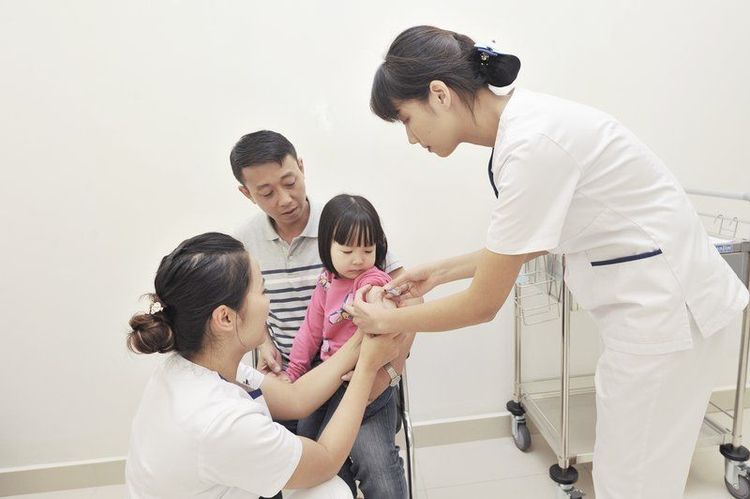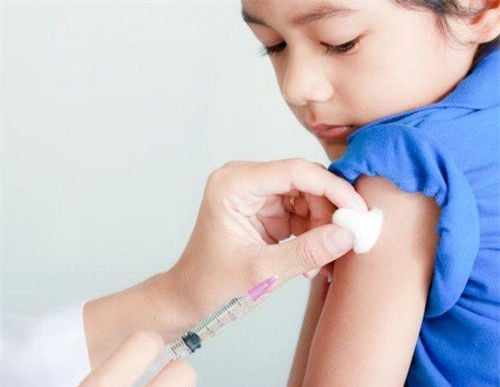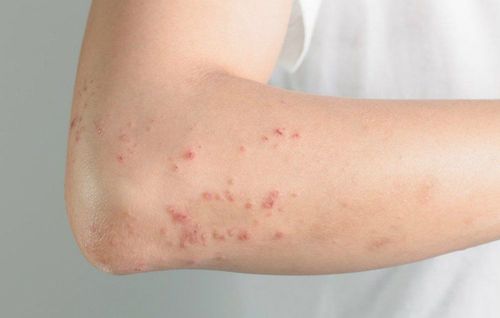This is an automatically translated article.
The article was professionally consulted by Specialist Doctor II Quach Nguyen Thu Thuy - Pediatric Center - Vinmec Times City International Hospital.
The appearance of vaccines is considered a great medical achievement of mankind because since the advent of vaccines, mankind has had the most effective and powerful weapon to actively prevent diseases. dangerous infectious diseases.
In the US, aware of the importance of using vaccines, most parents fully use vaccines for children as recommended by the Centers for Disease Control and Prevention (Centers for Disease Control and Prevention). Disease Control and Prevention (CDC), so that children are protected against 14 dangerous diseases before they are two years old. Using vaccines for children at the right time not only protects children but also increases the community's immunity, protecting those around them with weakened immune systems.
1. Reduce the risk of dangerous diseases

Người trên 65 tuổi cũng cần tiêm vắc-xin
As with other recommendations for young children, the vaccine schedule recommended by the Centers for Disease Control and Prevention has been studied before being introduced to ensure safety and effectiveness in protecting children. young guard. The vaccine schedule is based on the child's immune system response to the vaccine at different ages, and what pathogens are common in young children.
This is to ensure that children will be protected against 14 dangerous diseases common in young children such as diphtheria, pertussis, polio, tetanus, hepatitis B, Hemophilus influenza, pneumonia, pneumococcal ear infections , meningitis, measles, tuberculosis, mumps, Japanese encephalitis, rubella, and typhoid. 95% of vaccinated children will form an immune system to protect the body against dangerous infectious diseases. There is no evidence that intermittent use of vaccines provides safe or effective protection against diseases.
2. Prevention of complications
Delaying the use of vaccines can make children vulnerable to diseases, especially when they can face dangerous complications.Using vaccines is like putting on a helmet for a child. Helmets provide children with protection against injuries, and timely vaccinations protect children against serious illnesses. Young children are the most at-risk for serious complications. of disease. Therefore, vaccination will reduce the risks of diseases such as complications, sequelae, and death compared to the unvaccinated group.
3. Early protection for children against diseases

Hình ảnh tiêm vắc-xin lao tại Vimec
That's why leading experts pay special attention to the timing of vaccines for children. Vaccine schedules are designed to provide children with protection early in life, before they actually face potentially life-threatening illnesses.
4. Children need the highest level of protection and long-term protection. Creating conditions for children to grow up and develop comprehensively
Immunizations for children will avoid infectious diseases, children will develop healthily, without sequelae and malformations affecting the body and brain.Young children will not be able to get the best protection if they do not get all of the vaccines on the schedule and for the recommended number of times. Antibodies are transmitted from the mother and breast milk will not provide enough protection for the baby, because they only protect the baby for a short time after birth. A baby's immune system needs to fight off illnesses on its own, and the role of vaccines is to help protect them when the antibodies they received from their mother are gone.
Each vaccine has been carefully studied before it is approved to provide protection against specific diseases. Some vaccines require multiple administrations to provide optimal protection from an adequate immune response, or to fortify an immune response that has weakened over time. Using the vaccine more than once also prevents the child from producing enough antibodies after the first use. As for the flu, children need to be vaccinated every year because the flu virus mutates every year. Therefore, not only the vaccination schedule is important, but also the number of vaccination times is equally important.
5. Community benefits of vaccination
Unvaccinated children not only face the risk of disease, but also potentially pass the disease on to other unprotected people, such as newborn babies who have not yet received the vaccine. , immunocompromised people,... Using vaccines for children according to recommendations not only protects children but also helps protect those around them. Immunization not only helps protect a particular individual, but also helps prevent disease for the whole community. This is considered the most effective preventive measure to protect the health of the injectors and avoid the occurrence of major outbreaks affecting the health and life of the community.6. The role of hunger eradication, poverty reduction, and economic burden reduction
Vinmec International General Hospital always uses high-quality vaccines, of clear origin, suitable for the age to be vaccinated, ensuring safety from the stage of registration, storage to use for patients. all clients, whether children or adults:Children will be examined by pediatricians - vaccines, fully screened for health and physical problems, counseling on vaccines - Vaccination and vaccination regimens, how to monitor and care for children after vaccination before ordering vaccination according to the latest recommendations of the Ministry of Health & World Health Organization to ensure the best effectiveness and safest for children. A team of experienced and professional pediatric doctors and nurses, understand children's psychology and apply effective pain relief methods for children during the vaccination process. 100% of vaccinated children were monitored for 30 minutes after vaccination and reassessed before leaving. Undertake medical supervision before, during and after vaccination at Vinmec Health System and always have an emergency team ready to coordinate with the vaccination department to handle cases of anaphylaxis, respiratory failure - circulatory arrest, ensuring Ensure timely and correct handling when incidents occur. The vaccination room is airy, with a play area, helping children feel comfortable as if they are walking and have a good mentality before and after vaccination. Vaccines are imported and stored in a modern cold storage system, with a cold chain meeting GSP standards, keeping vaccines in the best conditions to ensure quality. Parents will receive a reminder message before the vaccination date and their child's vaccination information will be synchronized with the National Immunization Information System. Specialist II Quach Nguyen Thu Thuy has 35 years of experience in the field of Pediatrics. The doctor has been well-trained at home and abroad such as: Hanoi Medical University, Lilli University, French Republic. Before officially working at the Vaccine Unit - Children's Center - Vinmec Times City International Hospital, Dr. Thuy worked at Thanh Nhan Hospital and cooperated part-time with Vinmec International General Hospital. Times City.
Please dial HOTLINE for more information or register for an appointment HERE. Download MyVinmec app to make appointments faster and to manage your bookings easily.
Articles refer to the source: CDC













